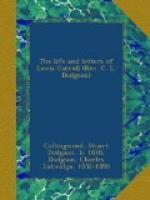[Footnote 002: The science of taking medicine in infinitely small doses.]
[Footnote 003:
1 _________________________ 1000000000000000000000000
]
[Footnote 004: A Man’s history of his own life.]
[Footnote 005: The author of “The Bandy-legged Butterfly.”]
[Footnote 006: Afterwards President of the Society for the Prevention of Cruelty to Animals.]
[Footnote 007: Or a pulling by the ear.]
[Footnote 008: This Rectory has been supposed to have been built in the time of Edward VI., but recent discoveries clearly assign its origin to a much earlier period. A stone has been found in an island formed by the river Tees on which is inscribed the letter “A,” which is justly conjectured to stand for the name of the great King Alfred, in whose reign this house was probably built.]
[Footnote 009: The poet entreats pardon for having represented a donkey under this dignified name.]
[Footnote 010: With reference to these remarkable animals see “Moans from the Miserable,” page 12.]
[Footnote 011: A full account of the history and misfortunes of these interesting creatures may be found in the first “Lay of Sorrow,” page 36.]
[Footnote 012: It is a singular fact that a donkey makes a point of returning any kicks offered to it.]
[Footnote 013: This valiant knight, besides having a heart of steel and nerves of iron, has been lately in the habit of carrying a brick in his eye.]
[Footnote 014: She was sister to both.]
[Footnote 015: The reader will probably be at a loss to discover the nature of this triumph, as no object was gained, and the donkey was obviously the victor; on this point, however, we are sorry to say, we can offer no good explanation.]
[Footnote 016: Much more acceptable to a true knight than “corn-land” which the Roman people were so foolish as to give to their daring champion, Horatius.]
[Footnote 017: Lewis Carroll composed this poem while staying with his cousins, the Misses Wilcox, at Whitburn, near Sunderland. To while away an evening the whole party sat down to a game of verse-making, and “Jabberwocky” was his contribution.]
[Footnote 018: Coesper from coena and vesper.]
[Footnote 019: Lubriciles, from lubricus and graciles. See the commentary in “Humpty Dumpty’s square,” which will also explain ultravia, and, if it requires explanation, moestenui.]
[Footnote 020: Sanguis meus: Verg. Aen. vi. 836—“Projice tela manu, sanguis meus!”]
[Footnote 021: Egnia: “muffish”—segnis; therefore “uffish” = egnis. This is a conjectural analogy, but I can suggest no better solution.]
[Footnote 022: Susuffrus: “whiffling,” susurrus: “whistling.”]
[Footnote 023: Spicula: see the picture.]
[Footnote 024: Burbur: apparently a labial variation of murmur, stronger but more dissonant.]




